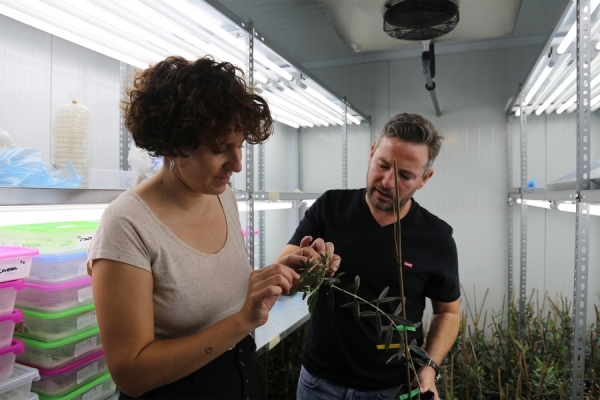Olive anthracnose is known in the field as 'soapy olive', alluding to the appearance ofits infected fruit, which ends up rotting. It is the most prevalent disease affecting olive trees, as it reduces harvests and has a negative impact on the quality of oil, causing significant economic losses.
Olive anthracnose is caused by different species of the genus Colletotrichum (to date, 18 species of this fungus have been identified as causal agents of the disease). In each olive-growing region there is a dominant Colletotrichum species, and many secondary species. For example, in Spain the dominant species is C. godetiae, which affects the susceptible variety 'Hojiblanca', which is very widespread in the country; while in Portugal C. nymphaeae stands out, affecting the 'Galega Vulgar'cultivar, which is very widespread in Portugal. The question is, what competitive relationships lead some species to dominate some regions and not others? Do they ″specialize″ more in a particular cultivar?
In search of answers, a team at the University of Cordoba’s María de Maeztu Unit of Excellence, Department of Agronomy (DAUCO),studied the relationships between these two species of Colletotrichum that cause anthracnose,to better understand their behavior and have more tools to deal with the disease.
To do so, "we carried out tests of isolates in Petri dishes with a mixture of spores of both species, testing in a medium enriched in carbon, and another that was poorer in it, to see which species dominated over the other, and if it had to do with the medium," explains researcher María Teresa García, the first author of the study. In all the tests, the C. godetiae species displaced C. nymphaeae, even if the percentage of spores in the initial inoculation was only 5% of C. godetiae versus 95% of C. nymphaeae. That is, even starting from a spore quantity disadvantage, this species managed to displace the other anyway.
Continuing the trials, they went on to use the combination of spores to inoculate olives of two cultivars susceptible to the pathogen (Hojiblanca, a characteristic variety of Andalusia; and Galega Vulgar, a dominant variety in Portugal), where the pattern was repeated: C. godetiae showed a greater competitive capacity and partially displaced the species C. nymphaeae. These results occurred in both cultivars, so it was ruled out that each was specialized in affecting one cultivar.
"We were surprised by these results, since it is logical that there would be a specialization in a region’s majority cultivar, or that there would be some characteristic allowing this fungus to dominate in Spain, with the other one on the margins, and the other way around in Portugal," stated researcher Juan Moral, coordinator of the study.
The results of the analysis of the relationship between the two species, both in Petri dishes and in fruit, regardless of cultivar, show that C. godetiae is much more competitive than the other species. In addition, this species was much more resistant to copper, which is the major fungicide in the olive orchards of both countries. How, then, can we explain that the most competitive species is not the dominant one in a region as close-by as Portugal?
"It is difficult to explain why C. godetiae no displaces C. nymphaeae in Portugal, according to the classical theory of competitive ecology" observes Moral. "However, it could also be due to what is known in ecology as the 'priority effect′;that is, when a species is established in a niche and becomes strong it is very difficult to displace it."Other doubts that the researchers have are whether this change is occurring ("we see a still picture of the population") or whether other factors (capacity to affect adventitious plants) have an influence on it.
This analysis, in addition to more thorough knowledge of the relationships between species,which will allow us, in the future, to know which majority populations are displacing others, and to issue better recommendations in the selection of fungicides, an efficient protocol is also obtained to simulate cycles of interaction between Colletotrichum species not just in olives, but also in other fruits.
Garcia-Lopez, M.T., Serrano, M.S., Camiletti, B.X. et al. Study of the competition between Colletotrichum godetiae and C. nymphaeae, two pathogenic species in olive. Sci Rep 13, 5344 (2023). https://doi.org/10.1038/s41598-023-32585-6


